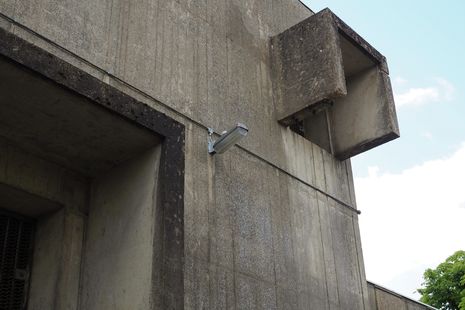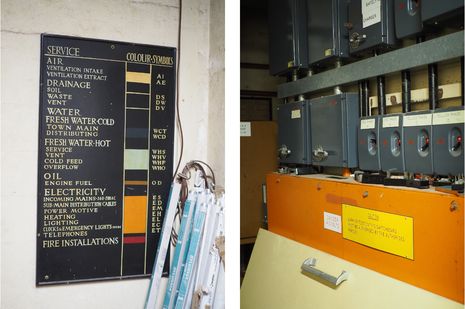Inside Cambridge’s nuclear bunker
From doomsday shelter to roman mosaic storage, Jonathan Liu ventures underground to explore the history and modern day usage of Cambridge’s not-so-secret nuclear bunker.

At the bottom of a sleepy housing estate off Brooklands Avenue lies Cambridge’s nuclear bunker. Though its external appearance has been softened by an overgrowth of ivy, its brutalist concrete structure is a reminder of its dark Cold War legacy. In the case of a nuclear attack, it would be from here, behind five feet of reinforced concrete, that a military government would run the East of England as the world outside fell into anarchy.
First built in 1953 as part of a series of 17 “War Rooms” scattered around the UK, the bunker could initially house 50 staff who would coordinate the local response to any major civil unrest following a nuclear attack. But with the additional threat posed by the Soviet Hydrogen bomb, the bunker had a massive extension in the 1960s to create a “Regional Seat of Government” with room for at least 450 people.
“It was like a mini county council office,” explains Steve Matthews, Cambridge University’s facilities manager. “They had a post office, police station, legal representation, a judge’s office. They even had a jail.” Civil servants from the Defence and Health Departments – as well as Pensions and Inland Revenue – were represented among the bunker’s personnel. In effect, even if Westminster were completely destroyed in the event of war, the machinery of central government could be replicated and continue to operate from this corner of Cambridge. After all, somebody has to administer the state pension and collect income tax post-nuclear apocalypse.
“Even if Westminster were completely destroyed in the event of war, the machinery of central government could be replicated.”
Today, entry to the old war room still requires passing through two enormous steel blast doors, behind which lies a dank maze of featureless concrete corridors and stairways. Littered around is detritus from an analogue Cold War past; old switchboards, air ducts and generators lie gathering dust. A plastic print-out of the Electricity (Factories Act) Special Regulations 1908 & 1944 lies propped up in the old plant room. There is a dark comfort in knowing that even in the event of a nuclear holocaust, the surviving bureaucrats would have made sure to uphold electrical usage regulations.

As we wander through the bunker’s interior, Steve Matthews explains how it would have run had war broke out: “People would get their call of ‘you need to come in’, they’d receive a code word, and then they’d have to leave their family”. Though he explains how the building was “completely self-contained, with its own power plants, water supply and drainage systems”, he notes there are few suggestions of home comforts. “Can you imagine being locked in here for up to 90 days […] waiting to find out what was going to happen with people banging on the door outside?” Steve asks.
Fortunately for all, the Cold War never did get hot. Having outlived the Soviet Union, the bunker was decommissioned in the 1990s, seeing its last service as a communications centre during the First Gulf War. Following that, it fell into a gradual state of disrepair until the University of Cambridge bought the derelict site in the 2000s. Potential uses as a data centre and as book storage for the University Library were explored, but eventually it was decided that it would house the collections of the Museum of Archaeology and Anthropology (MAA) as part of a new Centre for Material Culture.
“Today, walking inside feels a little like the end of Raiders of the Lost Ark.”
Though the interior of the older 1953 “War Room” section of the bunker has remained relatively unchanged, since 2021, the 1960s extension to the bunker has become a state-of-the-art storage facility. With its original purpose a far cry from museum storage, settling into the nuclear bunker has involved some getting used to for the collections staff. “I think what we’ve found difficult is there’s a silence to this place,” Lucie says. “We felt a slight sense of disconnection with others because these spaces are so big […] you can have lots of different people in this building, but you may never see them and you will never hear them”. Additionally, with the structure’s windowless design, Assistant Coordinator Katrina Dring finds that “you get a real sense of detachment from the world outside, especially when you leave in winter and it’s dark. You feel like you’re entering another world”.

Today, walking inside the storage collection feels a little like the end of Raiders of the Lost Ark when the holy grail is deposited in a vast warehouse full of archaeological objects. Except here, instead of being stuck inside featureless boxes, many of the items are open to see, giving a sense of the sheer scope in time and space that the museum’s collections represent. As I walk through, I pass by items as varied as a glossy Lion “fantasy coffin” from Ghana, a large section of Roman mosaic from Suffolk and a tunic from the Amazon bedecked in Jaguar teeth and tropical bird feathers.
As Lucie Carreau explained, this open display was a conscious choice. With heated discourse around decolonisation and repatriation in the museum world, Lucie Carreau recognises how it may look when potentially “quite sensitive” objects are taken into the bowels of a nuclear bunker with its “big, strong political and military kind of controlling legacy”. To remedy this, the collections team have been keen to ensure that this move to the nuclear bunker has been taken as an opportunity to open up to the public too.
With the bunker much larger than the previous storage site, Lucie explains “it’s easier to bring people in, it’s easier to get objects and share them with people”. The museum has started inviting schools and community groups, including those with cultural links to some of the objects, to visit and engage with the collection for the first time. Once they visit, with items now displayed in an accessible and sensitive manner, she hopes that, “there’s something to engage with when you’re in the store, rather than just endless, mysterious, collections in boxes, hidden away”.
Saved from decay and put to new use, this is perhaps the happiest of endings such a building could hope to receive. According to its original function, the bunker was a futile attempt to deny the reality of nuclear holocaust. Today, it represents a far more humble and noble goal. As I stand surrounded by this cross-section of the breadth and beauty of human creation, Lucie admits to me, “these objects won’t be safe forever, they aren’t designed to last forever. We’re fighting a battle that we cannot win”. Nevertheless, I have to say, it’s still a fight worth having.
 Features / Should I stay or should I go? Cambridge students and alumni reflect on how their memories stay with them15 December 2025
Features / Should I stay or should I go? Cambridge students and alumni reflect on how their memories stay with them15 December 2025 News / Cambridge study finds students learn better with notes than AI13 December 2025
News / Cambridge study finds students learn better with notes than AI13 December 2025 News / Dons warn PM about Vet School closure16 December 2025
News / Dons warn PM about Vet School closure16 December 2025 News / News In Brief: Michaelmas marriages, monogamous mammals, and messaging manipulation15 December 2025
News / News In Brief: Michaelmas marriages, monogamous mammals, and messaging manipulation15 December 2025 Comment / The magic of an eight-week term15 December 2025
Comment / The magic of an eight-week term15 December 2025









